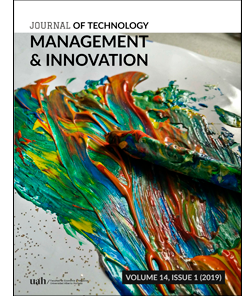A Systematic Review of the Debate and the Researchers of Disruptive Innovation
DOI:
https://doi.org/10.4067/S0718-27242019000100073Keywords:
disruptive innovation, disruptive technology, innovation, disruptionAbstract
Despite the popularity of the term “disruptive innovation”, its applications have taken on different meanings. Clayton Christensen is a prominent author in the field but his approach has not been applied in a consistent manner. To elucidate the use of the term in business studies, this paper employs a bibliometric approach to provide a descriptive analysis of researchers and their relevant works in the network formed by the related literature, in addition to distinguishing and grouping associated authors. The results suggest a dissimilarity of objectives between two subgroups using the term “disruptive innovation”, and the discussion about Clayton Christensen’s specific meaning of the term seems to make sense to only one of them.Downloads
References
Abernathy, W. J., & K. B. Clark. (1985). Innovation: mapping the winds of creative destruction. Research Policy, 14(1), 3-22. https://doi.org/10.1016/0048-7333(85)90021-6
Abernathy, W. J., & Utterback, J. M. (1978). Patterns of industrial innovation. MIT Technology Review, 80(7), 41-47.
Besanko, D., Dranove, D., & Shanley, M. (2004). Economics of strategy. Hoboken, NJ: Wiley.
Bower, J. L., & Christensen, C. M. (1995). Disruptive technologies: Catching the wave. Harvard Business Review, 73(1), 43-53.
Cândido, A. C. (2011). Inovação disruptiva: Reflexões sobre as suas características e implicações no mercado. Working paper 05-2011. Research Centre on Enterprise and Work Innovation. Faculdade de Ciências e Tecnologia da Universidade de Lisboa. Portugal. Retrieved from https://run.unl.pt/bitstream/10362/6912/1/WPSeries_05_2011ACC%C3%A2ndido-1.pdf
Christensen, C. M. (1997). The Innovator’s dilemma: When new technologies cause great firms to fail. Boston: Harvard Business School Press.
Christensen, C. M. (2006). The ongoing process of building a theory of disruption. Journal of Product Innovation Management, 23(1), 39-55. https://doi.org/10.1111/j.1540-5885.2005.00180.x
Christensen, C. M., & Bower J. L. (1996). Customer power, strategic investment, and the failure of leading firms. Strategic Management Journal, 17(3), 197-218. https://doi.org/10.1002/(SICI)1097-0266(199603)17:3<197::AID-SMJ804>3.0.CO;2-U
Christensen, C. M., & Overdorf, M. (2000). Meeting the challenge of disruptive change. Harvard Business Review, 78(2), 65-76.
Christensen, C. M., & Raynor, M. (2003). The Innovator’s solution: creating and sustaining successful growth. Boston: Harvard Business School Press.
Christensen, C. M., Anthony, S. D., & Roth, E. A. (2004). Seeing what’s next. Boston: Harvard Business School Press.
Christensen, C. M., Raynor, M., & McDonald, R. (2015). What is disruptive innovation? Harvard Business Review, 93(12), 44-53.
Daneels, E. (2004). Disruptive technology reconsidered: A critique and research agenda. Journal of Product Innovation Management, 21(4), 246-258. https://doi.org/10.1111/j.0737-6782.2004.00076.x
Garud, R., Kumaraswamy, A., & Langlois, R. (2003). Managing in the modular age: Architectures, networks, and organizations. Oxford: Blackwell.
Henderson, R. (2006). The innovator’s dilemma as a problem of organizational competence. Journal of Product Innovation Management, 23(1), 5-11. https://doi.org/10.1111/j.1540-5885.2005.00175.x
Henderson, R. M., & Clark, K. B. (1990). Architectural innovation: The reconfiguration of existing product technologies and the failure of established firms. Administrative Science Quarterly, 35(special issue: Technology, Organizations, and Innovations), 9-30.
Hill, C. W. L., Jones, G. R., & Schilling, M. A. (2015). Strategic management theory & cases: An integrated approach. Stanford: Cengage.
Hopp, C., Antons, D., Kaminski, J., & Salge, T. O. (2018a). Disruptive innovation: Conceptual foundations, empirical evidence, and research opportunities in the digital age. Journal of Product Innovation Management, 35(3), 446-457. https://doi.org/10.1111/jpim.12448
Hopp, C., Antons, D., Kaminski, J., & Salge, T. O. (2018b). The topic landscape of disruption research: A call for consolidation, reconciliation, and generalization. Journal of Product Innovation Management, 35(3), 458-487. https://doi.org/10.1111/jpim.12440
King, A. A., & Baatartogtokh, B. (2015). How useful is the theory of disruptive innovation? MIT Sloan Management Review, 57(1), 70-90.
Li, M., Porter, A. L., & Suominen, A. (2018). Insights into relationships between disruptive technology/innovation and emerging technology: A bibliometric perspective. Technological Forecasting and Social Change, 129(4), 285-296. https://doi.org/10.1016/j.techfore.2017.09.032
Markides, C. (2006). Disruptive innovation: In need of better theory. Journal of Product Innovation Management, 23(1), 19-25. https://doi.org/10.1111/j.1540-5885.2005.00177.x
Markides, C. (2013). Disruptive reality: making the leap into developed markets. Business Strategy Review, 24(3), 36-43. https://doi.org/10.1111/j.1467-8616.2013.00970.x
Nugi, B., Pelowski, M., & Ogembo, J. G. (2010). M-Pesa: A case study of the critical early adopters’ role in the rapid adoption of mobile banking in Kenya. The Electronic Journal on Information Systems in Developing Countries, 43(1), 1-16. https://doi.org/10.1002/j.1681-4835.2010.tb00307.x
Organisation for Economic Cooperation and Development (OCDE). (2005). Oslo Manual: The measurement of scientific and technological activities, 3rd Edition. OECD, Statistical Office of the European Communities. OECD Publishing, Paris.
Pilkington, A. (2009). Exploring the disruptive nature of disruptive technology. Paper presented at the 2009 International Conference on Industrial Engineering and Engineering Management (IEEM), Hong Kong.
Porter, M. E. (1985). Competitive advantage: Creating and sustaining superior performance. New York: Free Press.
Schiavi, G. S., & Behr, A. (2017). Modelos de negócios disruptivos: um estudo bibliométrico da produção científica disponível em bases de dados nacionais e internacionais. Paper presented at the 2017 International Conference on Information Resources Management (CONF-IRM), Santiago de Chile. Retrieved from https://aisel.aisnet.org/confirm2017/19
Schmidt, G. M., & Druehl, C. T. (2008). When is a disruptive innovation disruptive? Journal of Product Innovation Management, 25(4), 347-369. https://doi.org/10.1111/j.1540-5885.2008.00306.x
Schumpeter, J. A. (1912). The theory of economic development. Cambridge (MA): Harvard University Press.
Schumpeter, J. A. (2014). Capitalism, socialism and democracy. Floyd, VI: Impact Books. Original published in 1942.
Smith, A. (2007). An inquiry into the nature and causes of the wealth of nations. Edited by Sálvio M. Soares. MetaLibri, v.1.0p. Retrieved from http://metalibri.wikidot.com/title:an-inquiry-into-the-nature-and-causes-of-the-wealthof.Original work published in 1776.
Souza, I. D. S., & V. P. Takahashi. (2012). A vision of the future through prospective scenarios: A tool for the anticipation of disruptive innovation. Future Studies Research Journal, 4(2), 102-131.
The Economist. (2011). Aiming high: we launch a quarterly review of business books by considering six of the best. Business books. Retrieved from http://www.economist.com/node/18894875
Trott, P. (2008). Innovation management and new product development. New York: Prentice Hall.
Utterback, J. M., & W. J. A. Abernathy. (1975). Dynamic model of process and product innovation. Omega – International Journal of Management Science, 3(6), 639-656. https://doi.org/10.1016/0305-0483(75)90068-7
Downloads
Published
How to Cite
Issue
Section
License







